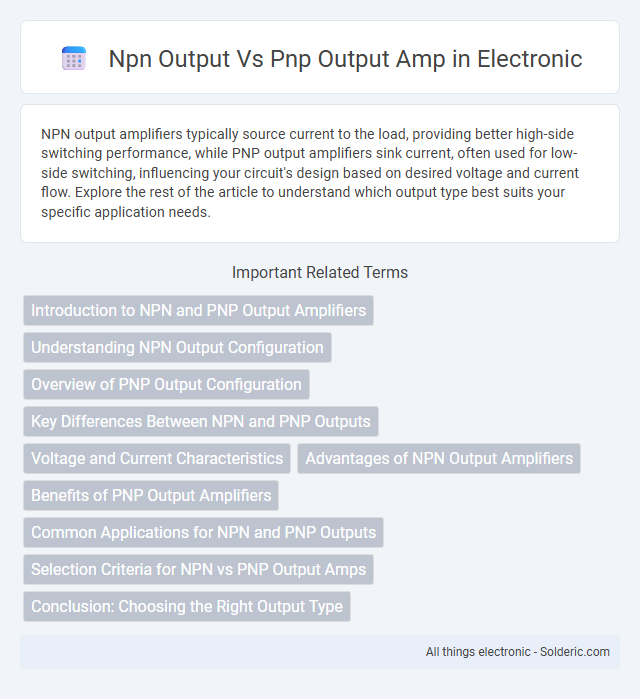NPN output amplifiers typically source current to the load, providing better high-side switching performance, while PNP output amplifiers sink current, often used for low-side switching, influencing your circuit's design based on desired voltage and current flow. Explore the rest of the article to understand which output type best suits your specific application needs.
Comparison Table
| Feature | NPN Output Amplifier | PNP Output Amplifier |
|---|---|---|
| Transistor Type | NPN Bipolar Junction Transistor | PNP Bipolar Junction Transistor |
| Current Flow | Collector to Emitter (positive current flow) | Emitter to Collector (negative current flow) |
| Output Stage | Sinking current (pulls current down) | Sourcing current (pushes current up) |
| Common Use | Positive voltage control, grounding load | Negative voltage or Vcc control, powering load |
| Switching Speed | Generally faster switching | Typically slower than NPN |
| Compatibility | Works well with low-side switching | Ideal for high-side switching |
| Biasing Requirements | Base more positive than emitter | Base more negative than emitter |
| Common Applications | Amplifiers, switches, digital circuits | High-side drivers, power supply controls |
Introduction to NPN and PNP Output Amplifiers
NPN output amplifiers use transistor configurations where the output current flows from the collector to the emitter, providing efficient switching and fast response times ideal for sinking current applications. PNP output amplifiers, in contrast, allow current to flow from the emitter to the collector, making them suitable for sourcing current to loads. Understanding the distinct polarity and current flow characteristics of NPN and PNP outputs is essential for optimizing amplifier performance in various electronic circuits.
Understanding NPN Output Configuration
NPN output configuration in amplifiers involves a transistor that switches the load to ground when activated, allowing current to flow from the load to the collector of the transistor. This setup is commonly used for sinking current, offering advantages such as faster switching speeds and ease of interfacing with digital logic that operates at lower voltage levels. Understanding how your NPN output amplifier drives current ensures proper integration with your circuit, optimizing performance and reliability.
Overview of PNP Output Configuration
PNP output configuration in amplifiers involves sourcing current to the load when activated, contrasting with NPN outputs that sink current. This setup is widely used in systems where the load needs to be connected to ground for activation, making it essential for positive switching logic. Understanding your amplifier's PNP output helps optimize circuit design, especially in automotive and industrial control applications.
Key Differences Between NPN and PNP Outputs
NPN output amplifiers source current by connecting the load to ground, allowing current to flow from the load through the transistor to the output, whereas PNP output amplifiers sink current by connecting the load to the positive voltage supply, enabling current flow from the power supply through the load into the output transistor. NPN transistors switch on when the base is driven high relative to the emitter, while PNP transistors switch on when the base is driven low. Understanding these key differences helps you select the appropriate output type based on your circuit design and voltage requirements.
Voltage and Current Characteristics
NPN output amplifiers typically have a voltage swing closer to the negative rail and allow current sinking capabilities, making them suitable for low-side switching applications. PNP output amplifiers provide voltage swing closer to the positive rail and excel in current sourcing, ideal for high-side switching tasks. The voltage and current characteristics of NPN and PNP outputs dictate their application in circuits, influencing signal integrity and power efficiency.
Advantages of NPN Output Amplifiers
NPN output amplifiers offer faster switching speeds and better saturation performance compared to PNP output types, making them ideal for high-speed applications. They provide greater current sinking capability, allowing your circuits to handle higher loads more efficiently. The widespread availability of NPN transistors ensures cost-effective and reliable performance in various amplifier designs.
Benefits of PNP Output Amplifiers
PNP output amplifiers offer improved noise immunity and better handling of negative voltage signals compared to NPN counterparts, enhancing overall circuit stability. Their ability to source current directly to the load reduces voltage drops, making them ideal for interfacing with positive voltage systems. You benefit from simpler wiring and increased reliability in applications requiring positive voltage outputs.
Common Applications for NPN and PNP Outputs
NPN outputs are commonly used in industrial automation systems for sinking current applications, such as driving LEDs, relays, or PLC inputs, particularly where the load connects to the positive voltage supply. PNP outputs are favored in sourcing current applications, typically found in sensor devices and automation circuits where the load is connected to ground, enabling easier integration with positive voltage systems. Both output types facilitate effective interfacing with various control devices, enhancing compatibility and system reliability in diverse electrical environments.
Selection Criteria for NPN vs PNP Output Amps
Selection criteria for NPN versus PNP output amplifiers hinge on load type, power supply configuration, and signal polarity requirements. NPN output amps are favored for sinking current applications and typically interface well with positive voltage loads and ground-referenced systems. PNP output amps, suited for sourcing current, are optimal for negative voltage loads and circuits requiring positive signal sourcing from the amplifier output.
Conclusion: Choosing the Right Output Type
Selecting the right output type, NPN or PNP, depends on your application's wiring and compatibility with existing systems. NPN outputs typically switch the load to ground, offering easier integration with negative-side loads, while PNP outputs source current to the load, suitable for positive-side switching. Understanding your system's voltage requirements and grounding scheme ensures optimal sensor amplifier performance and reliable operation.
npn output vs pnp output amp Infographic

 solderic.com
solderic.com